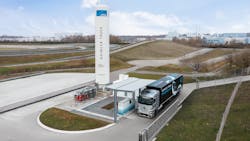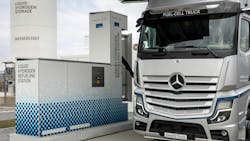A new method for handling subcooled liquid hydrogen allows for a higher storage density, a greater range, faster refueling, lower costs, and superior energy efficiency, according to Daimler Truck and Linde Engineering. The two companies announced that they have jointly developed sLH2, a new process for handling the fuel.
Refueling with the new method takes 10 to 15 minutes for a 40-ton heavy-duty truck, carrying 80 kg of liquid hydrogen for a range of 1,000 kilometers, according to the companies. The sLH2 technology also lowers the required investment for a hydrogen refueling station by a factor of two to three, and operational costs are five to six times lower.
The new process uses an sLH2 pump to slightly increase the pressure of the liquid hydrogen, causing it to become subcooled. Hydrogen in this state, according to the developers, facilitates a robust fueling process that also keeps energy losses during refueling to a minimum. Refueling capacity is also increased. The pilot refueling station has a capacity of 400 kg of liquid hydrogen per hour.
Read also: Komatsu Tests Hydrogen-Powered Excavator
“Zero-emission transport needs three factors: the right battery-electric and hydrogen-powered vehicles, the required infrastructure network, and cost parity for ZEVs compared to diesel trucks,” said Andreas Gorbach, member of the board of management of Daimler Truck AG, in a statement. “In terms of hydrogen infrastructure, we are reaching a major milestone today: With sLH2, hydrogen refueling becomes as convenient as today’s refueling with diesel. It takes about 10 to 15 minutes to fuel our Mercedes-Benz GenH2 Truck for a range of more than 1,000 kilometers.”
Said Juergen Nowicki, EVP of Linde plc and CEO of Linde Engineering, in a statement:
“Subcooled liquid hydrogen considerably increases the efficiency of hydrogen refueling systems. The required investment is reduced by a factor of two to three, and operational costs are five to six times lower. The technology we have developed with Daimler Truck will help pave the way for the development of a robust refueling network, which is essential to keep vehicles moving and supply chains intact.”
sLH2 Refueling Station Sets Benchmark
The new public sLH2 refueling station in Wörth am Rhein, Germany, sets a benchmark in terms of energy efficiency and performance, according to the companies. With energy consumption of only 0.05 KWh/kg, it requires approximately 30 times less energy compared with conventional gaseous hydrogen refueling.
The refueling station has a small footprint of 50 square meters (not including the dispenser) and allows for configurations where several dispensers for parallel refueling of trucks are possible, as well as back-to-back refueling. The liquid hydrogen storage tank has a capacity of 4 tons, sufficient for approximately 10 hours of nonstop refueling. The overall capacity of the fuel station can be increased to over 8 tons per day with refilling.
Read also: Nikola Opens Hydrogen Station
Daimler Truck and Linde Engineering intend to make sLH2 the leading hydrogen refueling technology for heavy-duty trucks, according to the companies. The technology has been standardized in an open ISO process and is available to all interested parties.
About the Author
Rod Sutton
Sutton has served as the editorial lead of Construction Equipment magazine and ConstructionEquipment.com since 2001.
Our mission is to help managers of heavy equipment and trucks to improve their performance in acquiring and managing their fleets. One way we do that is with our Executive Institute, where experts share information and ideas that will enable equipment managers to accurately manage equipment costs so that they can deliver the optimum financial benefits to their organizations.
We also have a laser focus on product development, performance, and technology; as well as equipment acquisition, disposal, and maintenance. Our exclusive Field Tests take earthmoving equipment and truck into the field for professional evaluations.
Check out our free newsletters to see the latest content.
You can find Sutton on LinkedIn.


